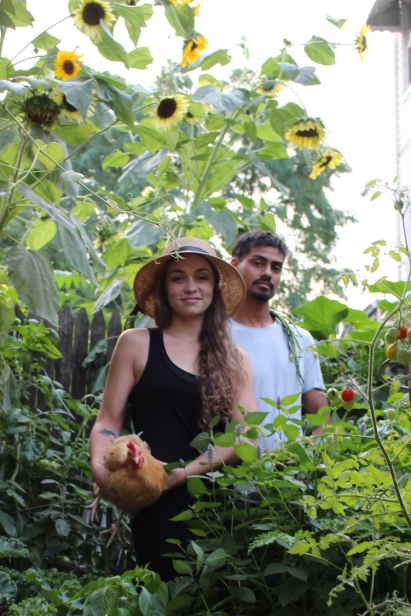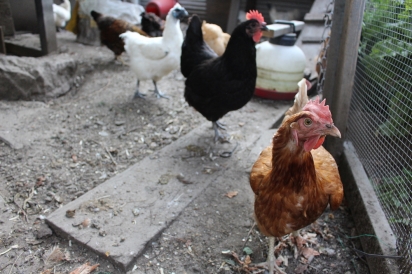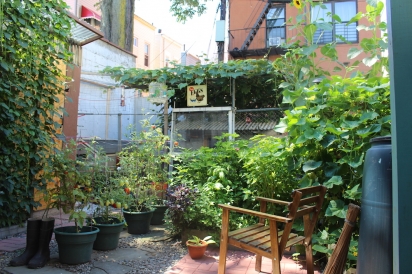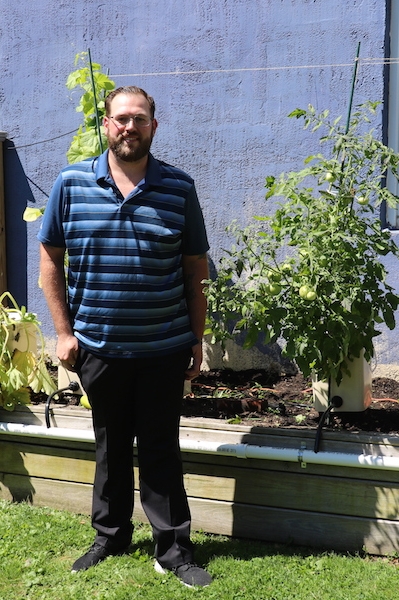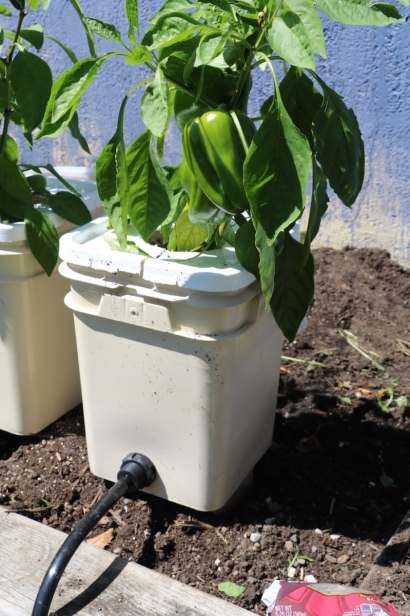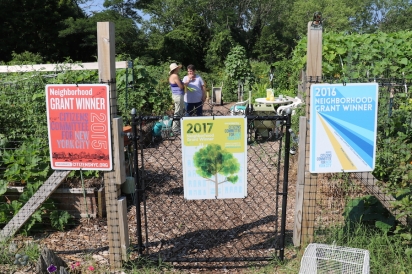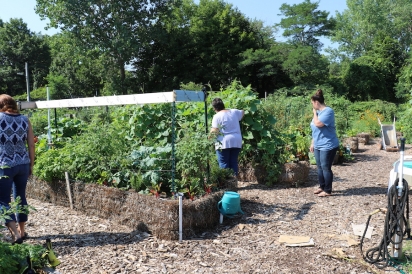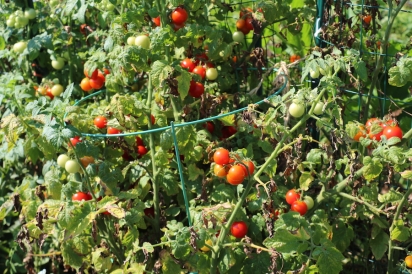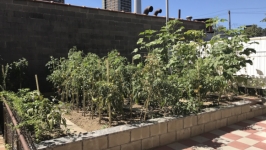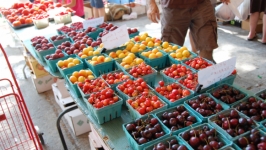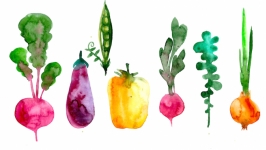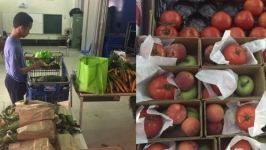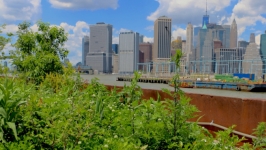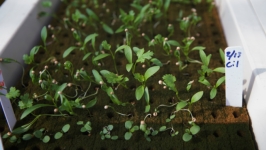Using Innovation in the Garden
Survival of the fittest does not mean that the strongest survive; it means that those who adapt to changing environmental conditions are the ones who survive. In the Bronx, gardeners are forced to deal with space limitations and poor soil quality. Innovation and adaptation is the common thread that connects the following gardeners.
Whether it be experienced or novice, alone, with their partner or as part of a community, they all use innovative techniques to improve their gardens and sometimes their communities, no matter what the conditions are.
First, I met up with Morgen Hall and Ejaz Hoosein recently to spend an evening discussing their garden in a tiny backyard off of Fordham Road in the Belmont section of the Bronx.
Ejaz: Three years ago, it was a blank canvas, just grass. We started with containers, then a raised bed reusing plywood we had leftover from a construction project. We built the chicken coop with a disassembled IKEA bunk bed and a vintage coffee table.
I laughed at the thought of reusing an IKEA piece, but noted that when working in an urban garden you’re forced to improvise!
Morgen: We have a 30’ by 20’ urban plot and we’re growing 50 different plants, a mixture of fruit, vegetables and herbs, plus we have chickens! We’re growing traditional vegetables from Guyana and it takes some effort to find seeds. We’ve had to resort to finding Guyanese markets, buying the produce and saving the seeds. By trial and error, we’ve managed to get things to grow in this Bronx climate.
Describe some of the problems you’ve had and how you’ve been able to correct them.
Ejaz: We had a problem with soil erosion at the bases of the grapevines and we found that grow bags did a good job of fixing the problem. We use PVC pipes stuck in the ground near the base of the grapevines and fill them with water. It helps with irrigation and doesn’t disturb the soil.
What is the biggest surprise or unexpected result you’ve experienced in the garden?
Ejaz: We started out growing food and created an oasis. We created it together and we discovered that spending time and communicating with your partner when you garden is special.
I met our next gardener, Rich Connolly, through our CSA. We stopped by his house, just up the road from the SUNY Maritime College, to check out his Dutch Bucket Hydroponics system.
Rich: I’ve been vegetable gardening for 7 years with raised beds. I wasn’t happy with how the bell peppers grew. No matter what I did. A buddy at work mentioned hydroponics. I watched a few YouTube videos and was intrigued by how much you can produce in a small bed. According to the videos I watched, what you can grow on 10 acres of a conventional garden, you could produce in a half acre with hydroponics. I was intrigued.
I’ve known you for a few years now and know you have been doing some home brewing and last year I got to spend a day with you and your family while you made fresh sausages. You seem to like to experiment.
Rich: The challenge of configuring and setting up the system definitely appealed to me. Because I was setting it up on top of our existing raised bed, I had to take care to elevate each bucket so that they were level and then stabilize them so they wouldn’t fall over. It would have been easier to set up the system on a level surface, but I have a raised bed and that’s the space I had to work with.
Any observations so far on how hydroponics is working? I realize this is your first year giving it a try.
Rich: Now that the system is set up and plants are growing, I’m continually noting how I will tweak the system for next year. For example, I have only one feed line and I’ve seen that creating even water pressure is extremely important. Next year, I will add a “T” connector at the pump to create a continuous loop that should do a better job of regulating water pressure. I’d like to increase the buckets/plants from 8 to 12 next year.
By sharing your garden, what do you hope to achieve?
Rich: Everyone should know that dirt or no dirt, you can grow. You don’t have to have a yard; you can grow on a balcony or a windowsill.
I met Deb Roff a few years ago. She had just done the trial run of a Straw Bale Garden in Edgewater Park. We spent an afternoon recently walking along the seawall, discussing the evolution of “The Garden in the Park”.
Deb: We started rogue gardening in 2001 at the site of an old boatyard that was part of the Edgewater Park property. The soil was rock hard, compacted so bad, you couldn’t get a shovel in it. In essence, we engineered our own soil remediation project by adding biodiversity and healing the soil. The sunflowers (nature’s soil engineer), iris and yarrow that we planted kept coming back year after year and we saw the soil getting healthier and healthier.
And sixteen years later, you’re working with engineers and biologists and talking about living shorelines and edible forests! I remember that your son gave you a copy of Joel Karsten’s “Straw Bale Gardening”. What made you decide to work with this method?
Deb: We did our first trial run in 2014. We liked the idea that the straw bales would then be composted and help us to create more healthy soil on a larger scale. We adapted the system by using the bales to outline the beds and filled them with soil. This is our third year and when you put a shovel into the soil, you can see and feel the difference.
What is the biggest surprise or unexpected result you’ve experienced in the garden?
Deb: The fact that non gardeners come to see it for the sheer joy of walking through it - that was a surprise.
By sharing your garden, what do you hope to achieve?
Deb: Communities don’t stay communities by themselves. People need to see that it takes groups of people to work together, it takes footwork, planning and did I say teamwork? But when you can watch the local children learn how to plant seeds, grow vegetables and enjoy eating them, it’s powerful.
And worth it!


